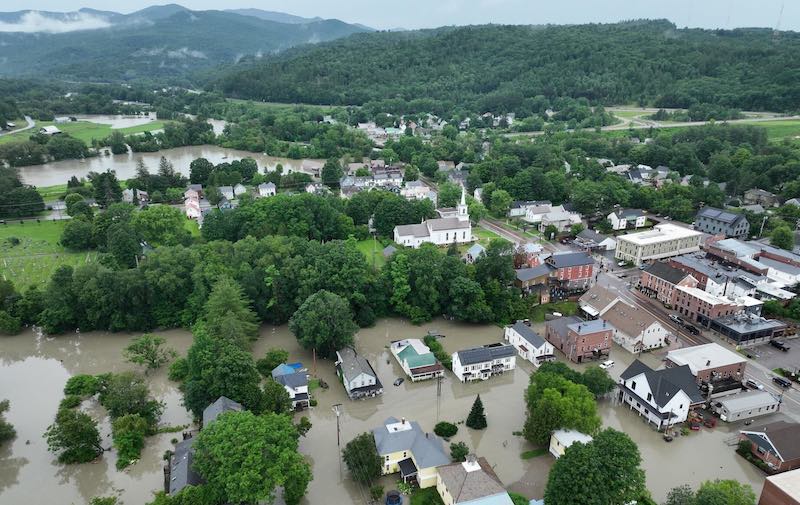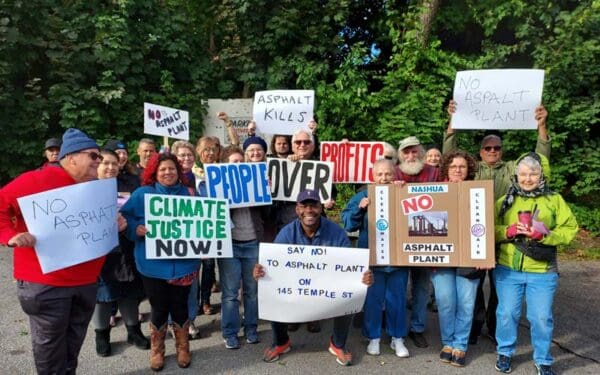
In July 2023, Vermont towns endured cataclysmic flooding after heavy rains, underscoring the need for climate change adaptation. Photo: Vince Franke
This fall, news broke that, as of September 11, there had been 23 confirmed weather/climate disaster events around the country this year, with total losses exceeding $1 billion.
We’ve watched hurricanes, wildfires, fierce storms, and floods unfold. In recent months, torrential rains inundated streets in Montpelier, Vermont, flooding homes and businesses. Almost 10 inches of rain fell in five hours in Leominster, Massachusetts, leading to evacuations and fear of a dam break. In Hawaii, a wildfire fueled by raging winds erased an entire town. And in California, a desert town was caked in mud following a rare hurricane.
The climate crisis is here. That means we must not only focus on how to prevent future climate impacts but also on how to preserve life and prevent damage to our homes, neighborhoods, and cities today.
And what should we be doing today? Simply this: We must drop the climate stopgaps and Band-Aids. Not only are they insufficient to meet today’s climate challenges, but they are costly to keep up, year after year. We can no longer continue our “business-as-usual” approach to meet the magnitude of our challenges.
A Systems Change Issue
Here’s the problem: Our thinking about climate resilience is fundamentally flawed and needs to change. Companies and governments seem content to spend billions to clean up after a storm, flood, or fire but are reluctant to make investments to prevent disaster in the first place. Government flood insurance and disaster relief programs step in following a calamity and are increasingly insufficient. They also have the unintended effect of “subsidizing” development in disaster-prone areas because they often require homeowners to rebuild exactly where they shouldn’t. At the same time, federal flood maps are outdated, leaving many homeowners ignorant of areas to avoid. The result: We keep seeing disaster hit the same places over and over again – and then repeat the same patterns of relief and rebuild.
Furthermore, as FEMA shores up flooded foundations and rebuilds charred walls year after year, we have yet to see the actual cost of all this momentary repair. The reason? Emergency appropriations to address these calamities are not included in the federal budget. Add to this the fact that while we may rush to patch up after a flood or fire, we consistently fail to address slower-moving climate change adversities like triple-digit temperatures.
We’ve got it backward. True climate resilience calls for long-term solutions that are less reflexive, often not popular, and informed by research and study. These measures must be crafted in partnership with and vetted by communities – particularly marginalized communities who disproportionately experience climate impacts. We must rethink how and where we build, retreat from zones likely to be hit repeatedly by floods and fires, and embrace the tools nature has given us to fortify ourselves against the ongoing realities of a changing climate. Most importantly, we must equitably provide the resources to do so.
And no, these things are not cheap – but such actions are far less costly than spending billions each year to reconstitute neighborhoods that are certain to be wiped out a few years or even months later.
True Resilience Calls for Bigger, Bolder Changes
The constant drumbeat of climate disasters should make it clear to legislators, policymakers, urban planners, and utility companies that we should think in a far more visionary manner than we have been. We can no longer accept the utilities’ standard cycle of making insubstantial repairs to powerlines after a storm, billing customers millions for those repairs, and then waiting for the next storm to do it again. It’s time for more substantive change, like introducing microgrids and rethinking powerline materials and placement that will harden infrastructure against today’s storms.
Innovative, nature-based solutions also must be part of the conversation. Parks along shorelines and waterways, green roofs, green corridors, rain gardens, wetlands, shared levees, sediment capture systems, and water-holding networks are ways to make our cities and towns more adaptive to climate change and less flood-prone. In New England, CLF has been involved in precisely these kinds of projects, partnering with local organizations and towns to build pop-up parks in Lawrence, Massachusetts, and plant trees in Manchester, New Hampshire, that can protect neighborhoods from extreme heat. Expanding floodplains, creating river corridors, and borrowing ideas from outside our region, like the living breakwaters project constructed off Staten Island, New York, must be included in a package of sweeping, future-oriented resilience strategies. Such projects look beyond just patching up and putting back.
A more visionary approach must extend to our homes and neighborhoods, too. While we retrofit our existing buildings and update our building standards to withstand intensified storms and heat, we must also plan for resilience hubs where neighbors can receive education and protection during extreme weather events.
Resilience At Home, Too
Fortunately, there is growing recognition in many statehouses of the urgent need to adapt and move beyond propping up today’s inadequate infrastructure. Across New England, we’ve seen some progress. But more must be done.
With $20 billion in resilience funding now available thanks to the Inflation Reduction Act, we have a tremendous opportunity. We can reshape and fortify our communities to withstand extreme weather next year and for years to come.
At CLF, we are redoubling our efforts to encourage well-considered, holistic resiliency planning that supports equitable outcomes while prioritizing high-risk communities that have been too often left to fend for themselves. And yes, such measures come at a cost. But the price of business-as-usual is far greater.




